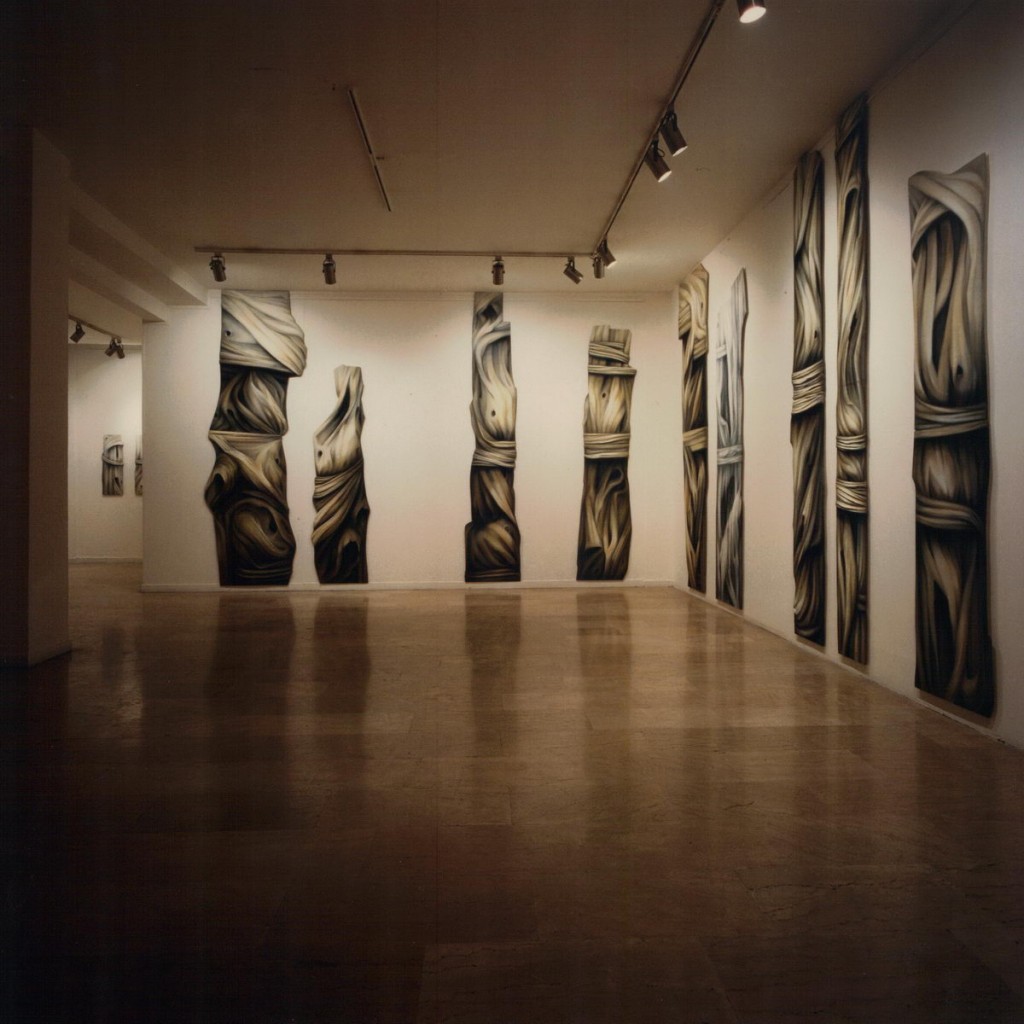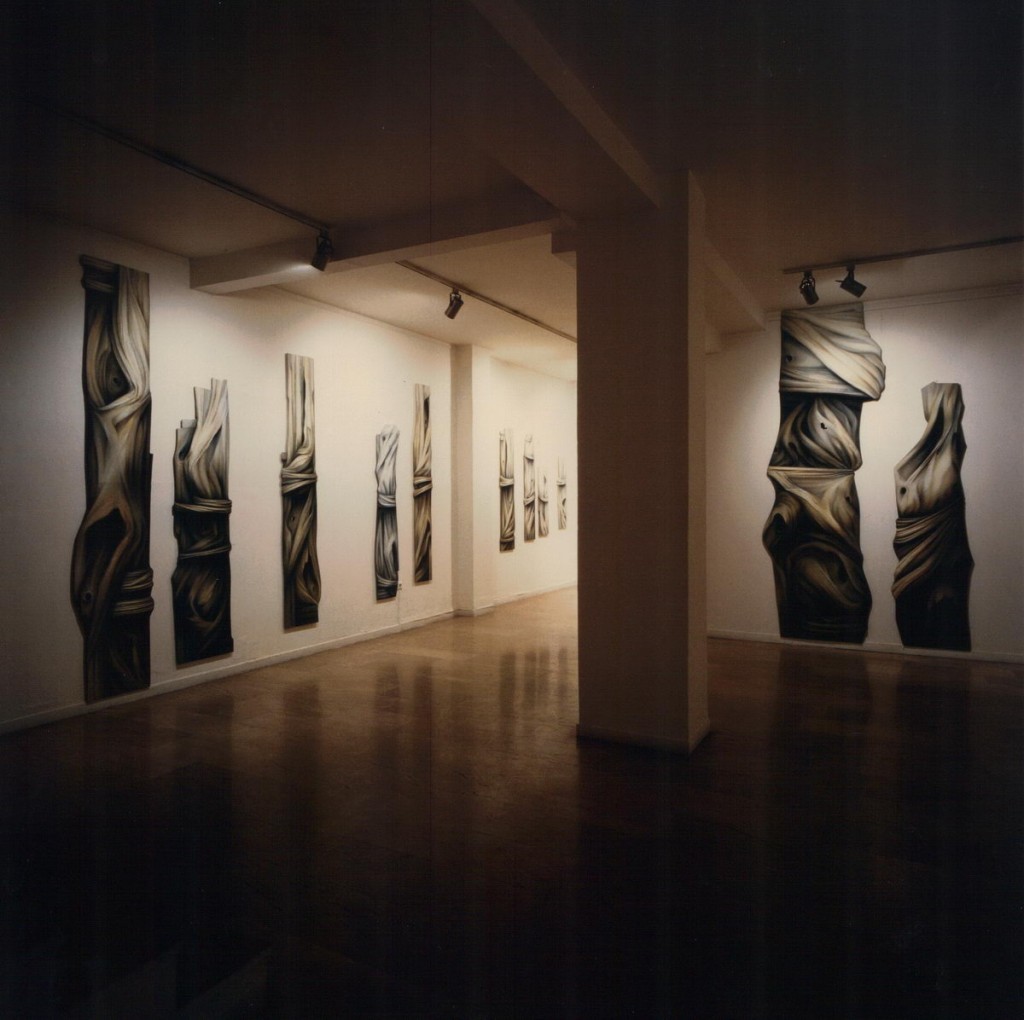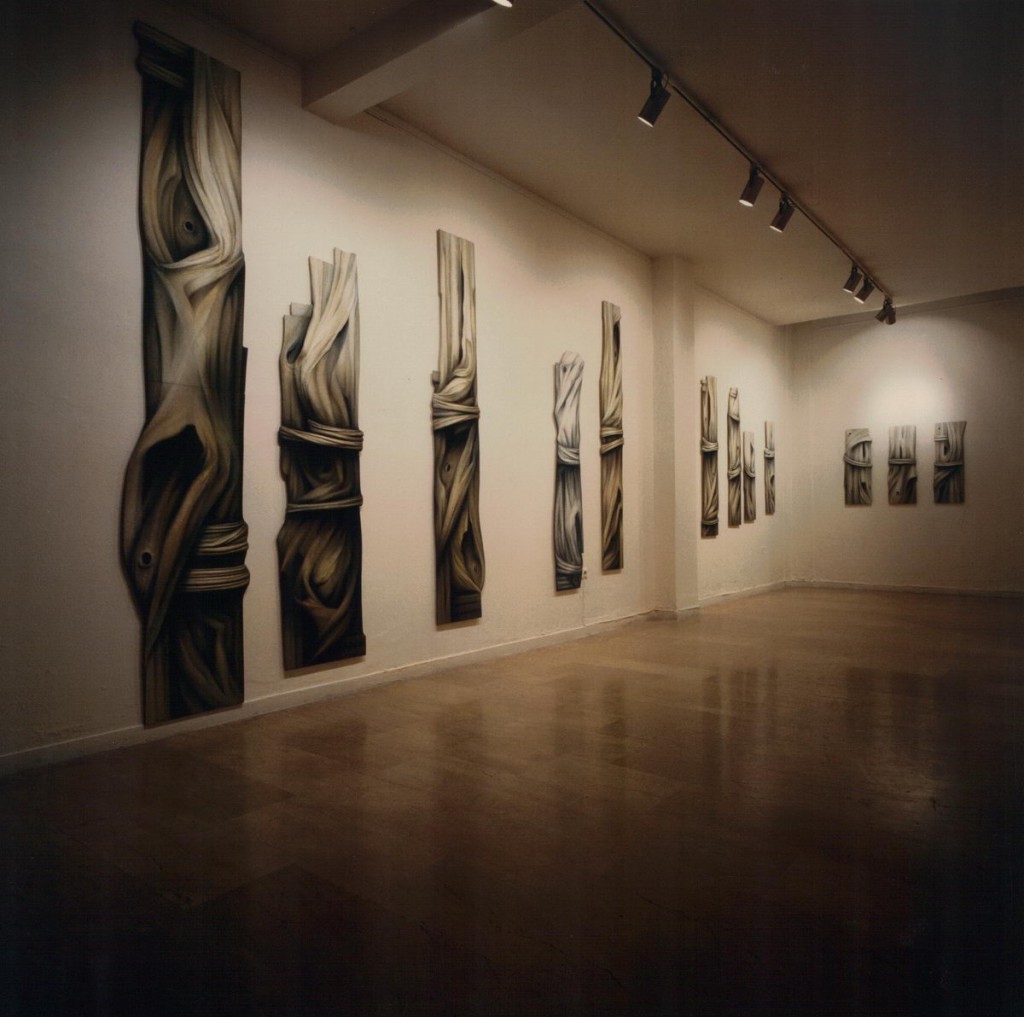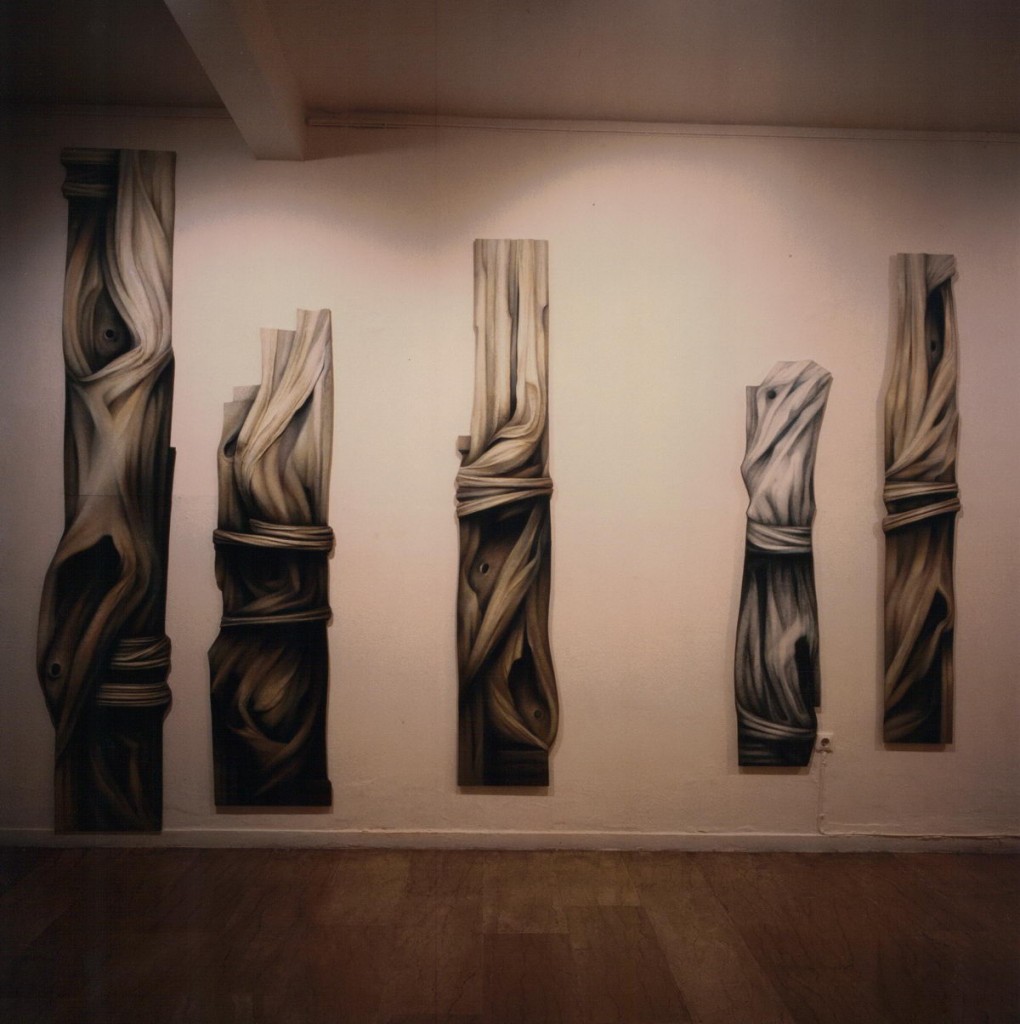(GR) ΕΛΕΥΘΕΡΟΤΥΠΙΑ
Κυριακή 7 Μαϊου 1995
Μαρία Μαραγκού
Στο κάδρο η Ειρήνη Απέργη
Έφυγε, αιφνίδια σχεδόν, λίγο πριν μπει το τελευταίο φθινόπωρο και την ξαναβρίσκουμε, άνοιξη, με όλα τα εξαίσια εκείνα τούλινα πανιά που έκαναν γεωμετρικές φόρμες. Η τελευταία δουλειά της Ειρήνης Απέργη, εκείνη που ετοίμαζε πυρετωδώς, ανάμεσα σε νοσοκομεία και δύσκολες επεμβάσεις συγκεντρωμένη ως τις 3 Ιουνίου στην γκαλερί «Μέδουσα»
Άγνωστη στο μεγάλο κοινό, ως το 1978 που άρχισε να εκθέτει, η Ειρήνη μένει ένα από τα δείγματα εκείνα της θέσης της γυναίκας στην κοινωνία της τέχνης, όσο προοδευμένη κι αν είναι η κοινωνία αυτή. Με δύο λόγια, το μεγάλο κομμάτι της ζωής της πέρασε στη σιωπή, δίπλα στη φήμη του συζύγου της, του γλύπτη Αχιλλέα Απέργη.
Η δουλειά της, όπως εμφανίζεται σε μια έκθεση στην «΄Ωρα» και σε τρείς εκθέσεις στη «Μέδουσα» περνά από τις μεικτές ύλες, τα ακρυλικά, τα χαρτόνια, τις γάζες, σε μικρό μέγεθος, στα περιβάλλοντα, στα οποία η εικόνα γεννιέται από την πιεστική ανάγκη έκφρασης, όπως γράφει ο Αλέξανδρος Ξύδης.
Τα τελευταία έργα της, κατασκευές στο χώρο, έχουν χάσει τα ζωηρά τους χρώματα για να περιβληθούν με τόνους ψυχρούς, γκρίζους και βαθιές μπλε σκιές, μια πτυχολογία, που έχει τη μακρινή αφετηρία της, στον Σκλάβο του Μιχαήλ Άγγελου, όπως γράφει στον κατάλογο που εκδόθηκε ο Χρύσανθος Χρήστου. Έχουμε τον άνθρωπο που αγωνίζεται για ότι τον εκμηδενίζει και ότι αρνείται την ανθρώπινη υπόσταση.
Το έργο της φωτογραφίας ανήκει σ’ αυτή τη σειρά των μνημειακών, επιτύμβιων σχεδόν έργων, που η Ειρήνη Απέργη δούλεψε, πυκνά και ουσιαστικά, με τις κερδισμένες από τα χρόνια πλαστικές της αξίες, τη δυνατότητα της ζωγραφικής και την αμεσότητα που είχε να εκφράζεται.
ΕΛΕΥΘΕΡΟΤΥΠΙΑ
Σάββατο 17 Ιουνίου 1995
Μαρία Μαραγκού
Το σώμα και η δικαίωση
Ετοίμαζε την έκθεση που παρουσιάζουμε σήμερα, τουλάχιστον τρία χρόνια. Χρόνο ελάχιστο και απέραντο μαζί.
Η πιο ώριμη, μεστή και πλήρης δουλειά της Ειρήνης Απέργη θα αρκούσε να αιτιολογήσει το πέρασμά της από την υπόθεση της τέχνης και να δικαιώσει τη ζωή της με το μερίδιο της γονιμότητας που της αναλογεί.
Φυσικά, πάντα κάτι παραπάνω ζητεί η καλλιτέχνης. Άπληστη στο μερίδιο του χρόνου που της αναλογεί, για ότι η ίδια πιστεύει πως άφησε ημιτελές.
Ο επισκέπτης της έκθεσης της Απέργη στην γκαλερί «Μέδουσα» δεν έχει ωστόσο αμφιβολίες. Πρόκειται για μια μνημειακή δουλειά, όχι επειδή η Ειρήνη την ολοκλήρωσε, αλλά δεν μπόρεσε να βρίσκεται στα εγκαίνιά της, αλλά επειδή το ίδιο το έργο, σαν φόρμα και σαν περιεχόμενο, συνδιαλέγεται με το μνημειακό.
Κατά τα άλλα, τα συγκινημένα αυτά έργα έχουν τη χαρά όλων εκείνων των δημιουργημάτων του ανθρώπου που ξεπερνά το όριο. Και την ικανοποίηση, πως η δημιουργός του κατάφερε όντως να ξεπεράσει το όριο, με ελάχιστα χρόνια δουλειάς. Πρώτη έκθεση, το 1978. Τελευταία, το 1995.
Πολλοί άνθρωποι επικαλούνται τη σεμνότητα. Ήταν από τις ελάχιστες πραγματικά σεμνές κι ας μην το επικαλέστηκε ποτέ. Δεν της το επέτρεπε εξάλλου εκείνο το φωτεινό χαμόγελο, η χαρά της ζωής που διαθέτουν όσοι μπορούν να δίνουν.
Σύζυγος του παραδεκτού από όλους γλύπτη Αχιλλέα Απέργη, δεν ήταν εύκολο να δείξει δημόσια όσα δούλευε. Η προβολή της υπόστασης εκ του ασφαλούς έχει άλλα μέτρα από εκείνη των επικίνδυνων ισορροπιών, σε ένα τόπο όπου βαραίνει συχνά τα παρά την τέχνη και όχι η ίδια η τέχνη. Κι ότι μοιάζει ακατανόητο για τις δικές μας γενιές, για τη δική της μπορεί και να ήταν κανόνας.
Το 1978 που η Απέργη έδειξε τη δουλειά της στην «¨Ωρα» και δύο χρόνια αργότερα στην γκαλερί «Σύγχρονη Χαρακτική», πάλευε με το χρώμα και τη φόρμα, με τη γεωμετρική αφαίρεση και τα περάσματα από τα λυρικά στα εξπρεσιονιστικά στοιχεία. Από εκεί κι ύστερα, η πορεία είναι αλματώδης. Αυτό που ως τότε βγαίνει προσεκτικά και μεθοδευμένα, με ακρυλικά χρώματα στο μουσαμά, φόρμα κουτιού, στη συνέχεια μεταφέρονται στο ξύλο που ορίζει το χώρο της φόρμας μετατρέποντάς την σε «Ποταμό» (1982) , σε «Πτώση» (1982), σε «Ουρανό» (1985).
Η ουσιαστική δουλειά της Ειρήνης Απέργη ξεκινά να διαγράφει την πορεία και τα αιτήματα που την οδηγού, το 1988 με τις περίφημες «Ρωγμές», που συνεχίζει ως το 1990. Είναι μια σειρά έργων με έντονο το εξπρεσιονιστικό στοιχείο, ελεύθερες φόρμες στο χώρο δουλεμένες με γάζες, ύφασμα, χρώμα, ύλες, ξύλο.
Στα τελευταία έργα, η μορφή έχει γίνει σώμα ανθρώπινο που διαλέγεται με τα δεσμά του. Οι πτυχώσεις είναι έντονες, το φως ελάχιστο, ίσα ίσα να αποκαλύπτει τις νοητές κούρβες που κάνει το τυλιγμένο σώμα όπως αγωνίζεται να ξεφύγει από ότι το περιβάλλει.
Η δράση είναι χαμηλότονη και βγαίνει μόνο με τον πλασμό, δίσως την παραμικρή υπερβολή. Δεν είναι όμως και τιθασευμένη. Η Ειρήνη Απέργη έχει απελευθερωθεί εντελώς από την αυτολογοκρισία των πρώιμων έργων της από την αυτοσυγκράτηση της δουλειά της προηγούμενης δεκαετίας.
Οι καλοί καλλιτέχνες έχουν μια πολύ καλή, καμιά φορά κορυφαία χρονική στιγμή, που καμιά αιτία δεν μπορεί να την προσδιορίσει ή να τη διαβλέψει. Είναι εκείνη που ορίζει το έργο τους και που επαναλαμβάνεται με διάφορους τρόπους σαν μανιέρα στις περιπτώσεις της ευκολίας ή ξεπερνιέται από κάτι άλλο, που μπορεί να είναι πολύ κατώτερο.
Η Ειρήνη Απέργη είχε την αγαθή τύχη, η δική της κορυφαία στιγμή να μη διακινδυνεύσει από επαναλήψεις ή παλινδρομήσεις.
Θα μείνει καθαρή, να ορίζει το πέρασμά της συναιρώντας το τέλος με την αρχή «Κυρία» Ειρήνη, καλημέρα.
Athens March 1995
Chrysanthos A.Christou
Prof. emeritus of art history-academician
THE ARTISTIC CREATION OF IRENE APERGIS AND RUMINATIONS ON SPACE, FROM THE STRICT GEOMETRIC VOCABULARY TO THE EMPHASIS ON THE ROLE OF COLOUR AND EXPRESSIONIST VALUES. STRANGE ACQUAINTANCES AND PERSONAL RESTATEMENSTS. HER MOST RECENT EFFORTS ARE A COMBINATION OF BIOMORHIC KINETIC ELEMENTS, PLASTIC AND PAINTERLY VALUES.
Irene Apergis, an artist whose recent death saddened us all, worked quietly, with consistency and continuity, alongside her husband, the well known sculptor Achilleas Apergis. Although she had managed to achieve her own purely personal morphoplastic idiom at an early age, it was not until relatively late, i.e. from 1978 on that she began to exhibit her works in one man and group exhibitions. Those who knew her understood that her hesitation was not due to fear of facing criticism but of the fact that she did not want anyone to think that she was in competition with or influenced her husband. Thus, although there was virtually no relationship between her painting and Achilleas Apergis’ sculpture, since she moved in a different stylistic direction, she remained hidden and unknown to the general public, with the exception of a few friends. Quietly and tirelessly, Iren Apergis continued her searching, broadened her morphoplastic idiom, completed her statements and up to the last days of her life, was making plans for an exhibition of her works in each category and dreaming of going on in new directions.
What is impressive in the artistic creation of Irene Apergis is more than anything else the orientation of her ruminations on the shaping of space that interested her and which she sought to organize and interpret, but internal , purely physic space the she sought to shape. All her wanderings through various stylistic trends and all her searching in the use of media and new techniques are associated precisely with her effort to delve deeper into and show more clearly the problem of external and internal space. Her morphoplastic idiom became broader and richer; her organization was transformed and metamorphosed; her color application altered, passing from common to contrasting colors, from lyric to expressionistic ones, to the same end. The relatively early works of Irene Apergis which were exhibited in 1979 at “Ora” as well as those exhibited at the “Contemporary Graphics” gallery in 1980, move within the climate of patterns of geometric abstraction. These are works based on square and rectangular themes, rhythmically repeated elements and in most, uniform colors.
Thus she gives us groupings in which space is organized, rhythmic relationships are imposed and- with the emphasis sometimes on the vertical and at others on horizontal themes, squares or rectangles –combinations are conveyed and emotions expressed. In many cases the use of the color blue, intensified by the interpolation of other colors which may even be diagonally connected, expresses a more romantic feeling of escape. Apergis took a step further in her works painted in 1981-1982, which were first presented in Medusa Art Gallery in 1982.Because at that time, without having abandoned the geometric idiom, she was attempting in two different ways to express more clearly the need to shape and interpret space. In the first she dealt with the same themes both on the wall and as nomads on the floor ; in the second she combined more intensively aggressive and passive elements, warm and cool colors, static and kinetic features. Her works were moving within the framework of depicting plastic elements and the art of the environment, a fact which helped her to arrive at richer expressive extensions. For now her works, environments, paintings and plastic art, were distinguishable for their dynamic and expansionist element, suggesting multidimensional space, expressing internal vibrations.
During the years that followed, Irene Apergis abandoned her geometric idiom and uniform colors, and for the exhibitions in 1985 and 1988, both in the Medusa Gallery, she produced works which move in a completely opposite direction. Because she was then turning more to emphasizing the role of color and expressionist values, and more clearly to themes that sometimes were freely moving and at others were personal combinations of static and kinetic patterns. In a work bearing the general title “Fissures”, one is especially impressed with the use of patterns from various directions in a strictly personal manner. Thus she combines elements from the well known American trend to use hard angles in painting and with another characteristic American trend using color strips, but in a completely new spirit and with clearly new expressive extensions. She uses simultaneously hard angles as exterior frames and color strips as interior elements on the painted surface with extremely expressive results. She never confines herself to single pure colors as seen in works by overseas artists, but rather she uses combinations of all kinds and accented contrasts which are distinguishable for the more expressionistic content of their voice. In this way we have works which constitute splendid combinations of austerity and freedom, geometric and expressionistic elements, aggressive features and allusive tones. In fact, Apergis shapes different unities with the works in this category which give the impression that some collaborate and others conflict, that some continue and others refute each other. Here also one can perceive that Apergis has become increasingly interested in combining purely painterly values with plastic statements, a direction which she pursues by using her morphoplastic idiom as well as the media themselves and their textures.
From 1989 on, one notes a withdrawal from the role of expressionist values, which is accompanied by a certain tendency to restrict the role of contrasting colors. At the same time one can readily perceive a trend toward reinforcing the role of the purely plastic values, accompanied externally by her shift toward more vertical shapes. And while features and patterns are retained from her previous efforts, there are completely new elements which play a decisive role in her works. In some of her most characteristic efforts during the 1990-1993 period, it was not just accentuated plastic values which set the tone, but the emphasis on cooler, grayish and ashy colors together with the verticality which show a different encounter with the world and with life. In her groupings which consist of different monads with corresponding features, verticality, plastic elements and ascetic colors viewers have the impression that they are facing particularly schematized human forms. Indeed the manner in which they are rendered, by motifs reminiscent of zones sometimes in the middle and at to hers in other, horizontal and diagonal positions, they suggest to the viewer a world imprisoned. With these figures at different heights which can be more or less than two meters, we have a kind of frieze through which encounters and associations in all categories are integrated.
Because these forms, in essence schematized and fragmented human bodies, for which she has used common elements and parallel motifs, plastic values and ascetic, cool colors together with the accentuated verticality, appear as forces which confront the world. A world, in any case, in which it bonds of all kinds which play a decisive role, external and internal bonds, contrasts, prejudices and superstitions. Perhaps a hint can be found in the fact that the title which Irene Apergis planned to give to the grouping was “Memories”, which she herself wrote on a slide she sent to the writer of these remarks just before she died. Memories of her own problems, her own links with life and her own difficulties in art. With these freeze figures- she schematized, essentially human bodies- she gives us a group on which all searching are recapitulated and her own purely personal statements are imposed.
Because in the works in this series, one becomes aware of her potential in design and her ability to utilize purely plastic values as well as the expressive voice of color. And while, from a distance, one I struck by the richness and expressive power of the plastic patterns, as one approaches the works one is drawn by the quality of the drawing and the nature of the color.In some of the works in this series one has the impression that Apergis depicts human bodies which are struggling to rid themselves not only of their clothing with its emphasized drapery, but also of their very selves. With twisted motifs, diagonal and horizontal elements, such as the emphasis on curved features, a kind of internal struggle for deliverance is conveyed to the viewer. Perhaps the most interesting point that should be noted is the fact that it is never Apergis’ purpose to depict or describe something but rather to suggest what viewers must fill in themselves. Her morphoplastic idiom and supplementary motifs, organizations and chromatic language are other elements used elliptically and allusively to this end. In this series, which Apergis worked on during the last years of her life, she succeeds admirably in combining the achievements of painting and the statements of plastic art; as she succeeded in combining internality with the allusive power of color, with emphasis on the role of volumes and the cooperation between levels of plasticity in a unity rich in expressive extensions
. In fact, to this last series of works, in the figures of schematized human bodies she attempts to render man’s eternal struggle with anything that consists and rejects him. And it may be considered very bold, but perhaps the distant starting points of this series were Michelangelo‘s Bound Slave and Dying Slave. Because any careful study and any substantial approach to this series of Apergis’ figures can only point to the conclusion that we are talking about the same struggle. We have human beings who are struggling against whatever annihilates them and whatever rejects the human existence. In some of Apergis’ figures, one does not merely see it, but literally lives it. And this is without a trace of excess, but only with the personal use of pure plastic values and the possibilities offered by painting. An artistic creation which is distinguished for its authenticity and directness, the expressive richness and honesty of its statements.
Catalogue text
Alexandros Xydis
Athens 28.3.95
Irene Apergis appeared but briefly on the center stage og Greek painting. She was the modest, genial companion of a great sculptor and proud mother of a wonder- child who, while still a young man, made a name for himself as composer in France.
Irene Apergis appeared quite suddenly in the ORA gallery in 1972 with works of a mature, austere abstractive disposition that were, in fact projected in space. After that three exhibitions were held at Medusa (1982, 1985, 1988) and one or two elsewhere of mixed media works- acrylic, cardboard, plywood, wood fabrics, gauze- combined in “environments”, as she used to call them, full of poetry and lightness. Sometimes they recalled to the viewer’s eyes flocks of migratory birds crossing the seas, sometimes windows opening out into eternity, through clouds whose passing revealed a patch of blue sky. But they were neither representational nor decorative. They brought to mind very specific images which convinced you that they had been generated by an urgent need for expression, in an idiom stemming from the deepest core of her being. The conscious rejection of any realism, any representationality, was the most impressive feature of Apergis’ works from the outset. It was a basic choice which covered her entire career. She pursued it with calm decisiveness, without ostentation or emotionalism, but with an almost mystic devotion to what can only be called her vision.
Among Apergis’ most recent works, however, her latest constructions have lost their vivid colors - the reds, light blues, tender pinks and yellows. They were encompassed by cool tones, grey with shadows of deep blue, almost black. The drapery in her current long, narrow shapes is distantly related to Michelangelo’s bound “Slaves”. They resemble standing nude human figures, completely wrapped in a shroud, as though tied to a stake, with a nipple here, a navel there, black orifices which demarcate the human body, shadow figures from the dreams of another life which Irene was destined to look upon so soon.








